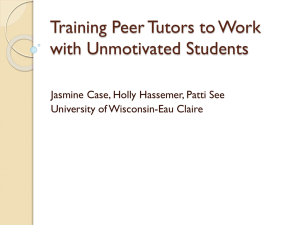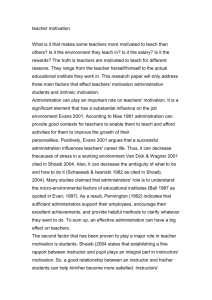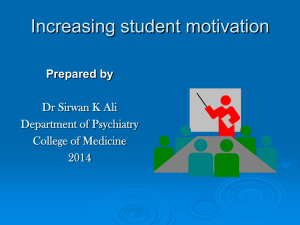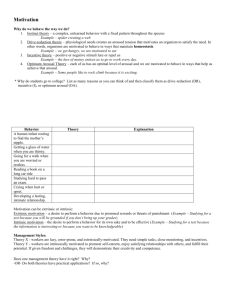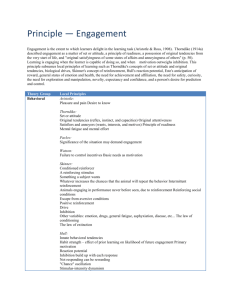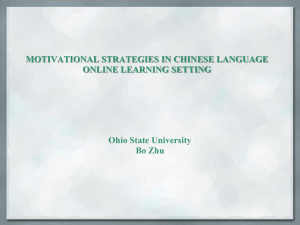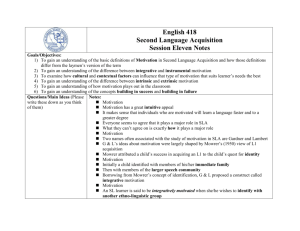File
advertisement
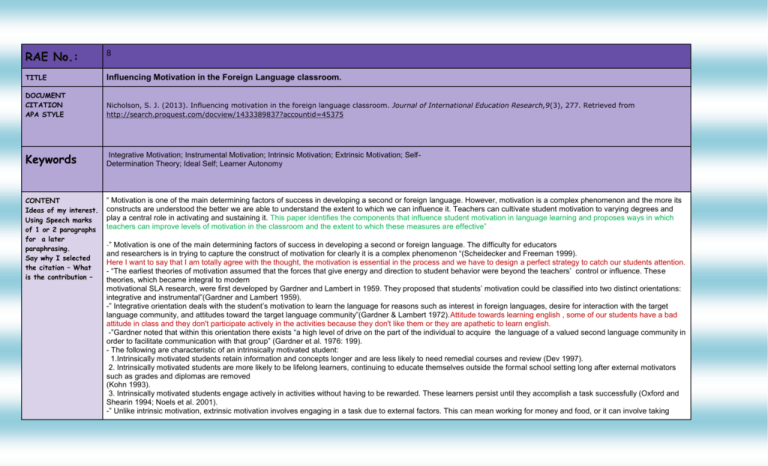
RAE No.: 8 TITLE Influencing Motivation in the Foreign Language classroom. DOCUMENT CITATION APA STYLE Nicholson, S. J. (2013). Influencing motivation in the foreign language classroom. Journal of International Education Research,9(3), 277. Retrieved from http://search.proquest.com/docview/1433389837?accountid=45375 Keywords Integrative Motivation; Instrumental Motivation; Intrinsic Motivation; Extrinsic Motivation; SelfDetermination Theory; Ideal Self; Learner Autonomy CONTENT Ideas of my interest. Using Speech marks of 1 or 2 paragraphs for a later paraphrasing. Say why I selected the citation – What is the contribution – “ Motivation is one of the main determining factors of success in developing a second or foreign language. However, motivation is a complex phenomenon and the more its constructs are understood the better we are able to understand the extent to which we can influence it. Teachers can cultivate student motivation to varying degrees and play a central role in activating and sustaining it. This paper identifies the components that influence student motivation in language learning and proposes ways in which teachers can improve levels of motivation in the classroom and the extent to which these measures are effective” -” Motivation is one of the main determining factors of success in developing a second or foreign language. The difficulty for educators and researchers is in trying to capture the construct of motivation for clearly it is a complex phenomenon “(Scheidecker and Freeman 1999). Here I want to say that I am totally agree with the thought, the motivation is essential in the process and we have to design a perfect strategy to catch our students attention. - “The earliest theories of motivation assumed that the forces that give energy and direction to student behavior were beyond the teachers’ control or influence. These theories, which became integral to modern motivational SLA research, were first developed by Gardner and Lambert in 1959. They proposed that students’ motivation could be classified into two distinct orientations: integrative and instrumental”(Gardner and Lambert 1959). -” Integrative orientation deals with the student’s motivation to learn the language for reasons such as interest in foreign languages, desire for interaction with the target language community, and attitudes toward the target language community”(Gardner & Lambert 1972).Attitude towards learning english , some of our students have a bad attitude in class and they don't participate actively in the activities because they don't like them or they are apathetic to learn english. -”Gardner noted that within this orientation there exists “a high level of drive on the part of the individual to acquire the language of a valued second language community in order to facilitate communication with that group” (Gardner et al. 1976: 199). - The following are characteristic of an intrinsically motivated student: 1.Intrinsically motivated students retain information and concepts longer and are less likely to need remedial courses and review (Dev 1997). 2. Intrinsically motivated students are more likely to be lifelong learners, continuing to educate themselves outside the formal school setting long after external motivators such as grades and diplomas are removed (Kohn 1993). 3. Intrinsically motivated students engage actively in activities without having to be rewarded. These learners persist until they accomplish a task successfully (Oxford and Shearin 1994; Noels et al. 2001). -” Unlike intrinsic motivation, extrinsic motivation involves engaging in a task due to external factors. This can mean working for money and food, or it can involve taking actions to avoid harm. As Dornyei explains,“extrinsic motivation refers to behaviors that ‘the individual performs to receive some extrinsic reward’ such as getting good grades, being praised by the teacher or to avoid punishment” (Dornyei 1994a: 275). -- Deci and Ryan (1985) contend that self-determination theory reintroduces a component of motivation that has long been neglected by most modern cognitive motivational theories: psychological needs. 1.Self-determination :theory focuses on the three following needs, which appear to enhance intrinsic motivation (Ryan & Deci 2000): 2. Competence: feeling capable of learning English well. Relationships/Relatedness: feeling welcome from the teachers and English speaking community. 3.Autonomy: feeling that English is chosen by the student rather than imposed. “Another key factor that motivates students to learn a language is the degree to which they are intrinsically motivated. “Intrinsically motivated students learn an L2 because of the inherent pleasure in doing so” (Oxford & Sharon 1994; Noels et al. 2001; cited in Liu 2007: 128), and it is this intrinsic motivation that leads students to maintain their effort and engagement in the L2 learning process. - Teachers can make a positive contribution to students’ motivation to learn if classrooms are places that students enjoy coming to because the content is interesting and relevant to their age and level of ability (2006: 64)it is very important the classroom will be a different environment where the students are motivated to learn english. -” An integral component to L2 motivation is learner confidence and there are various strategies the teacher can employ to help increase learner confidence in the classroom. As Pae suggests, “Intrinsic motivation should be promoted in a way that maximizes learners’ self-confidence and motivation, which in turn will bring about increased L2 achievement” (2008: 23). In Dornyei’s (1994 a: 281) breakdown of how to motivate L2 learners, he suggests that teachers can develop students’ self -confidence by engaging in the following behaviors: 1. Trusting students and projecting the belief that they can achieve their goal. 2. Regularly providing praise, encouragement and reinforcement. 3.Ensuring students regularly experience success and a sense of achievement. 4.Helping to remove uncertainties about their competence and self-efficacy by giving relevant positive examples and analogies of accomplishment. 5. Counterbalancing experiences of frustration by involving students in more favorable, “easier” activities. 6.Using confidence-building tasks in the classroom “ Having examined the predominant motivational theories in the SLA literature the author was able to identify key factors that influence student motivation in language learning. Using this as a point of departure, the writer then went on to outline ways in which teachers can improve motivation levels in the classroom before addressing the extent to which these measures can effectively improve student motivation. It is clear that motivation plays a crucial role in foreign language learning and achievement, and as Oxford and Shearin (1994) observe, “Without knowing where the roots of motivation lie, how can teachers water the roots?” (p. 15). Therefore, understanding the constructs of this complex phenomenon puts educators in a better position to develop motivation in their students and “water the roots”. However, the author would like to suggest that teachers not only focus on ways to improve levels of motivation in the classroom, but that they direct their efforts into sustaining students’ motivational capacity as they strive for “excellence, autonomy and self -actualization” (Brown 2000: 165). . DEFINITIONS Definitions of some -Motivation is one of the main determining factors of success in developing a second or foreign language. -Another key factor that motivates students to learn a language is the degree to which they are intrinsically motivated. “Intrinsically motivated students learn an L2 because important words like attitude or motivation taken from different authors - Does it coincide with my own definition? of the inherent pleasure in doing so” COMMENTS – QUESTIONS TO ANSWER It is very important the classroom will be a different environment where the students are motivated to learn english , the intrinsic motivation specifically.

